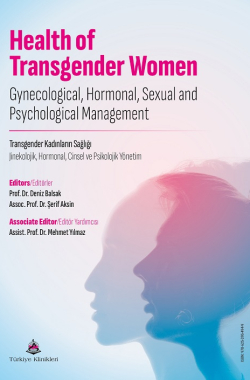SOCIAL COHESION IN TRANSGENDER WOMEN
Emine Füsun Akyüz Çim
İstanbul Demiroğlu Bilim University, Faculty of Medicine, Istanbul Florence Nightingale Hospital, Department of Psychiatry, İstanbul, Türkiye
Akyüz Çim EF. Social Cohesion in Transgender Women. Balsak D, Aksin Ş, eds. Health of Transgender Women: Gynecological, Hormonal, Sexual and Psychological Management. 1st ed. Ankara: Türkiye Klinikleri; 2025. p.279-285.
ABSTRACT
Social cohesion is defined as the state of living in social harmony by behaving in accordance with social rules, values, and expectations. The ability to integrate into society within the framework of mutual respect while preserving individual identity is considered one of the fundamental elements of social cohesion. Individuals are expected to be in a social structure where they feel safe and peaceful in a cooperative and mutually understanding relationship. The notion of social cohesion is widely regarded as a means of mitigating conflicts stemming from social differences while concurrently fostering principles of justice and inclusivity. Cultural, ethnic, and religious variations among social groups have the potential to engender discord, thereby impeding social cohesion. In contemporary society, numerous minority groups encounter significant impediments to the attainment of social cohesion, attributable to their distinctive characteristics. Transgender women, who are categorized within sexual identity minority groups, are likewise perceived to be confronted with considerable challenges in achieving social cohesion.
Transgender women do not adopt the gender identity biologically assigned to them at birth, thus challenging established gender norms. The cisgenderist belief system, shaped by social sexual identity, has adopted prejudiced thinking and negative behavior patterns that invalidate the sexual identity of minorities. Consequently, transgender women face various forms of discrimination, prejudice, and stigmatization at both the individual and societal levels. This social environment engenders considerable challenges for transgender individuals in navigating social adaptation.
The factors that affect the social cohesion of transgender women can be evaluated under the following subheadings: stigmatization, violence, difficulties related to health services, and invisible discrimination in public spaces. It is imperative to raise awareness about these issues that erode social cohesion and to devise effective solutions that are not only implemented on an individual level but also in institutional, legal, and political contexts.
Keywords: Gender identity; Social cohesion; Social discrimination; Stigmatization; Transgender woman
Kaynak Göster
Referanslar
- Kornienko O, Santos CE, Martin CL, Granger KL. Peer influence on gender identity development in adolescence. Dev Psychol.2016;52(10):1578-92. [Crossref] [PubMed]
- Dickey LM, Hendricks ML, Bockting WO. Innovations in research with transgender and gender nonconforming people and their communities. Psychol Sex Orientat Gend Divers.2016;3(2):187-94. [Crossref]
- King W, Hughto JMW, Operario D. Transgender stigma: a critical scoping review of definitions, domains, and measures used in empirical research. Soc Sci Med. 2020;250:112867. [Crossref] [PubMed] [PMC]
- Maksut JL, Scheim AI, Sanchez TH, Wiginton JM, Lyons CE, Logie CH, et al. Gender identity and sexual behavior stigmas, severe psychological distress, and suicidality in an online sample of transgender women in the United States. AnnEpidemiol.2020;52:15-22. [Crossref] [PubMed] [PMC]
- White Hughto J, Reisner S, Pachankis J. Transgender stigma and health: A critical review of stigma determinants, mechanisms, and interventions. Soc Sci Med. 2015;147:222-31. [Crossref] [PubMed] [PMC]
- Transgender Europe (TGEU). Trans Murder Monitoring (TMM) Update: Trans Day of Remembrance 2022 [Internet]. 2022 [cited 2023 Mar 28]. Available from: [Link]
- Muñoz Martínez R, Fernández Casanueva C, González O, Morales Miranda S, Brouwer KC. Struggling bodies at the border: migration, violence and HIV vulnerability in the Mexico/Guatemala border region. Anthropol Med. 2020;27(4):363-79. [Crossref] [PubMed]
- Anzani A, Sacchi S, Prunas A. Microaggressions towards lesbian and transgender women: Biased information gathering when working alongside gender and sexual minorities. J Clin Psychol. 2021;77(9):2027-40. [Crossref] [PubMed] [PMC]
- James SE, Herman JL, Rankin S, Keisling M, Mottet L, Anafi M. The report of the 2015 U.S. Transgender Survey [Internet]. Washington, DC: National Center for Transgender Equality 2016 [cited 2019 Sep 30]. [Link]
- Klemmer CL, Arayasirikul S, Raymond HF. Transphobia-based violence, depression, and anxiety in transgender women: The role of body satisfaction. J Interpers Violence. 2021;36(5-6):2633-2655. [Crossref] [PubMed]
- Jaffee KD, Shires DA, Stroumsa D. Discrimination and delayed health care among transgender women and men: Implications for improving medical education and health care delivery. Med Care. 2016;54(11):1010-6. [Crossref] [PubMed]
- Zuzelo PR. Improving nursing care for lesbian, bisexual, and transgender women. J Obstet Gynecol Neonatal Nurs. 2014;43(4):520-30. [Crossref] [PubMed]
- Gamarel KE, King WM, Mouzoon R, Xie H, Stanislaus V, Iwamoto M, et al. A "tax" on gender affirmation and safety: costs and benefits of intranational migration for transgender young adults in the San Francisco Bay area. Cult Health Sex. 2021;23(12):1763-78. [Crossref] [PubMed] [PMC]
- McAuliffe M, Oucho LA (eds.). World Migration Report 2024. International Organization for Migration (IOM). 2024. Geneva. [Link]
- Perez-Brumer A, Salazar X, Nunez-Curto A, D'Amico L, Aguayo-Romero R, Reisner SL, et al. Intersectional stigma and the arc of intranational migration: experiences of transgender adolescents and women who migrate within Peru. BMC Public Health. 2023 Jun 21;23(1):1202. [Crossref] [PubMed] [PMC]
- Baral S, Beyrer C, Muessig K, Poteat T, Wirtz AL, Decker MR, et al. Burden of HIV among female sex workers in low-income and middle-income countries: a systematic review and meta-analysis. Lancet Infect Dis. 2012;12(7):538-49. [Crossref] [PubMed]
- Baral SD, Poteat T, Strömdahl S, Wirtz AL, Guadamuz TE, Beyrer C. Worldwide burden of HIV in transgender women: a systematic review and meta-analysis. Lancet Infect Dis. 2013;13(3):214-22. [Crossref] [PubMed]
- Preciado PB. Lixo e Gênero. Mijar/Cagar. Revista Select. 2018;Mar. Accessed December 15, 2020. [Link]
- Bagagli BP, Chaves TV, Zoppi Fontana MG. Trans women and public restrooms: the legal discourse and its violence. Front Sociol. 2021;6:652777. [Crossref] [PubMed] [PMC]

